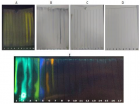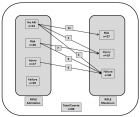Abstract
Research Article
Pharmacological effects of Nephrolepis exaltata L. (fern) aqueous extract on an insect-based model (Nauphoeta cinerea)
Sandro Rostelato-Ferreira*, Danrley Mariel Egidio Sanchez, Jocimar de Souza and Yoko Oshima-Franco
Published: 27 March, 2018 | Volume 2 - Issue 1 | Pages: 031-036
In this work we used semi-isolated heart of the cockroach Nauphoeta cinerea for the investigation of the pharmacological effects of extracts (aqueous, 1:1, 1:2, 1:4 and 1:8) from Nephrolepis exaltata L. leaves, a popular ornamental fern considered to be safe. The use of insects in experimental studies has grown due to the easy handling, proliferation/growing assuring its rapid obtention, and absence of ethical issues. An aqueous extract 0.2 % was obtained after maceration of 1 g N. exaltata leaves powder with 20 mL of distilled water (1:20). Diluted extracts in water were obtained to have the following proportion 1:1, 1:2, 1:4 and 1:8. Experiments (n=4) consisted of 200 µL addition onto semi-isolated heart preparation of N. cinerea with concomitant heart beating counting. Aqueous, 1:1 and 1:2 extracts paralyzed completely the heart beatings of cockroachs (p<0.05 compared to saline control), but not 1:4 or 1:8, which showed only a slight decline (p>0.05 compared to saline control). A preliminary thin layer chromatography showed the presence of unidentified terpenoid in aqueous extract of N. exaltata. These pharmacological findings of N. exaltata can be exploited for future use as insecticide or as dose-dependently cholinergic agent.
Read Full Article HTML DOI: 10.29328/journal.jpsp.1001017 Cite this Article Read Full Article PDF
Keywords:
Cockroach; Fern; Insecticidal
References
- Der Marderosian A, Giller F, Roia FJr. Phytochemical and toxicological screening of household plants potentially toxic to humans. Journal of Toxicology and Environmental Health. 1976; 1: 939-953. Ref.: https://goo.gl/uiHKdT
- Geller-Bernstein CC, Keynan N, Bejerano A, Shomer-Ilan A, Waisel Y. Positive skin tests to fern spore extracts in atopic patients. Annals of Allergy. 1987; 58: 125-127. Ref.: https://goo.gl/BT2Stb
- Stoof TJ, Bruynzeel DP. Contact allergy to Nephrolepis ferns. Contact Dermatitis. 1989; 20: 234-235. Ref.: https://goo.gl/kFmXZU
- Andersen F, Paulsen E. Allergic contact dermatitis caused by the Boston fern Nephrolepis exaltata 'Bostoniensis'. Contact Dermatitis. 2016; 75: 255-256. Ref.: https://goo.gl/QoCEDy
- Mironowicz A, Kromer K, Pawlowicz P, Siewinski A. Abilities of some higher plants to hydrolyze the acetates of phenols and aromatic-aliphatic alcohols. Acta Societatis Botanicorum Poloniae. 1994; 63: 43-48. Ref.: https://goo.gl/n9v7JS
- Tu S, Ma L, Luongo T. Root exudates and arsenic accumulation in arsenic hyperaccumulating Pteris vittata and non-hyperaccumulatting Nephrolepis exaltata. Plant Soil. 2004; 258: 9-19. Ref.: https://goo.gl/CBajgA
- Chen J, Shiyab S, Han FX, Monts DL, Waggoner CA, et al. Bioaccumulation and physiological effects of mercury in Pteris vittata and Nephrolepis exaltata. Ecotoxicology. 2009; 18: 110-121. Ref.: https://goo.gl/SD8WVc
- Samarakkody R, Chathuranga D, Perera I, Fonseka DLCK, Iqbal MCM. Removal of cadmium (II) from contaminated soil by Nephrolepis exaltata. Conference: Interhational Symposium on Agriculture and Environment. 2014.
- Rao RAK, Khan U. Adsorption studies of Cu (II) on Boston fern (Nephrolepis exaltata Schott cv. Bostoniensis) leaves. Applied Water Science. 2017; 7: 2051-2061. Ref.: https://goo.gl/7cuLXb
- El-Tantawy ME, Shams MM, Affi MS. Chemical composition and biological evaluation of the volatile constituents from the aerial parts of Nephrolepis exaltata (L.) and Nephrolepis cordifolia (L.) C. Presl grown in Egypt. Natural Product Research. 2016; 30: 1197-1201. Ref.: https://goo.gl/7LUVmb
- Edwards JS. The action and compostion of the saliva of an assassin bug Platymeris rhadamanthus Gaerst. (Hemiptera, Reduviidae). Journal of Experimental Biology. 1961; 38: 61-77. Ref.: https://goo.gl/kRhC8y
- Rodrigues NR, Nunes ME, Silva DG, Zemolin AP, Meinerz DF, et al. Is the lobster cockroach Nauphoeta cinerea a valuable model for evaluating mercury induced oxidative stress? Chemosphere. 2013; 92: 1177-1182. Ref.: https://goo.gl/yYDtVQ
- Nicolopoulou-Stamati P, Maipas S, Kotampasi C, Stamatis P, Hens L. Chemical Pesticides and Human Health: The Urgent Need for a New Concept in Agriculture. Front Public Health. 2016; 4: 148. Ref.: https://goo.gl/mnw2J9
- Farmacopéia Brasileira. 4ª edição. São Paulo: Editora Atheneu. 1988.
- Rodrigues V, Dörr FA, Morbi B, Pinto E, Dal Belo CA, et al. Effects of a cyanobacterial extract containing-anatoxin-a(s) um the cardiac rhythm of Leurolestes circunvagans. Brazilian Journal of Pharmacognosy. 2012; 22: 775-781. Ref.: https://goo.gl/R6a4iD
- Barreto YC, Leal AP, Oliveira RS, Vinadé L, Santos TG, Dal Belo CA. Atividade neurotóxica do veneno de Rhinella ictérica (Spix, 1824) em baratas da espécie Nauphoeta cinerea. In: Anais do Salão Internacional de Ensino, Pesquisa e Extensão (SIEPE): 2016; Rio Grande do Sul. Rio Grande do Sul, RS: Universidade Federal do Pampa. 2016; 8. Ref.: https://goo.gl/GhjJR1
- Harbone JB. Phytochemical Methods: A Guide to Modern Techniques of Plants Analysis. Chapman & Hall, London, England, 3rd Edition. 1998.
- Simões CMO, Schenkel EP, Gosmann G, Mello JCP, Mentz LA and Petrovick PR. Farmacognosia: da Planta ao Medicamento. UFRGS/UFSC, Porto Alegre/Florianópolis, Brazil, 5th Edition. 2004.
- Costa, KN, Gomes RM, Farrapo NM, Franco YO. Validação Farmacológica de Fitoqúimicos Comerciais sob o Parâmetro da Junção Neuromuscular (JNM) e do Perfil Cromatográfico. In: Oliveira JM, Gerenutti M, Miranda RC, Franco YO, Franzoni V. Os Múltiplos Olhares da Pesquisa: da observação ao conhecimento (pp. 13-29). Sorocaba: Eduniso 2011.
- MeSH, Adrenaline. https://www.ncbi.nlm.nih.gov/mesh/?term=adrenaline Accessed 15/03/2018.
- MeSH, Acetylcholine. https://www.ncbi.nlm.nih.gov/mesh/?term=acetylcholine. Accessed 15/03/2018.
- Fryer AD, Maclagan J. Ipratropium bromide potentiates bronchoconstriction induced by vagal nerve stimulation in the guinea-pig. European Journal of Pharmacolgy. 1987; 139: 187-191. Ref.: https://goo.gl/3mE39W
- Hennequin S, Hovenkamp P, Christenhusz M, Schneider H. Phylogenetics and biogeography of Nephrolepis -a tale of old settlers and young tramps. Botanical Journal of the Linnean Society. 2010; 164: 113-127. Ref.: https://goo.gl/6wkaDb
- Kennedy DO, Wightman EL. Herbal extracts and phytochemicals: plant secondary metabolites and the enhancement of human brain function. Advances in Nutrition. 2011; 2: 32-50. Ref.: https://goo.gl/LypRwq
- Rattan RS. Mechanism of action of insecticidal secondary metabolites of plant origin. Crop Protection. 2010; 29: 913-920. Ref.: https://goo.gl/hwC6ez
Figures:

Figure 1

Figure 2

Figure 3
Similar Articles
-
Pharmacological effects of Nephrolepis exaltata L. (fern) aqueous extract on an insect-based model (Nauphoeta cinerea)Sandro Rostelato-Ferreira*,Danrley Mariel Egidio Sanchez,Jocimar de Souza,Yoko Oshima-Franco. Pharmacological effects of Nephrolepis exaltata L. (fern) aqueous extract on an insect-based model (Nauphoeta cinerea). . 2018 doi: 10.29328/journal.jpsp.1001017; 2: 031-036
Recently Viewed
-
Euthanasia: Growing Acceptance amid Lingering ReluctanceTshibambe N Tshimbombu,Immanuel Olarinde,Judea Wiggins*,Maxwell Vergo. Euthanasia: Growing Acceptance amid Lingering Reluctance. Clin J Nurs Care Pract. 2025: doi: 10.29328/journal.cjncp.1001058; 9: 001-006
-
Community, health and rehabilitationAlessandro Giustini*. Community, health and rehabilitation. J Community Med Health Solut. 2023: doi: 10.29328/journal.jcmhs.1001025; 4: 001-003
-
Case Report: Intussusception in an Infant with Respiratory Syncytial Virus (RSV) Infection and Post-Operative Wound DehiscenceLamin Makalo*,Orlianys Ruiz Perez,Benjamin Martin,Cherno S Jallow,Momodou Lamin Jobarteh,Alagie Baldeh,Abdul Malik Fye,Fatoumatta Jitteh,Isatou Bah. Case Report: Intussusception in an Infant with Respiratory Syncytial Virus (RSV) Infection and Post-Operative Wound Dehiscence. J Community Med Health Solut. 2025: doi: 10.29328/journal.jcmhs.1001051; 6: 001-004
-
Requirement for object-oriented database management systems in forensic scienceGesine Rempp A,Volkmar Vill*. Requirement for object-oriented database management systems in forensic science. J Forensic Sci Res. 2023: doi: 10.29328/journal.jfsr.1001042; 7: 001-003
-
Sinonasal Myxoma Extending into the Orbit in a 4-Year Old: A Case PresentationJulian A Purrinos*, Ramzi Younis. Sinonasal Myxoma Extending into the Orbit in a 4-Year Old: A Case Presentation. Arch Case Rep. 2024: doi: 10.29328/journal.acr.1001099; 8: 075-077
Most Viewed
-
Evaluation of Biostimulants Based on Recovered Protein Hydrolysates from Animal By-products as Plant Growth EnhancersH Pérez-Aguilar*, M Lacruz-Asaro, F Arán-Ais. Evaluation of Biostimulants Based on Recovered Protein Hydrolysates from Animal By-products as Plant Growth Enhancers. J Plant Sci Phytopathol. 2023 doi: 10.29328/journal.jpsp.1001104; 7: 042-047
-
Sinonasal Myxoma Extending into the Orbit in a 4-Year Old: A Case PresentationJulian A Purrinos*, Ramzi Younis. Sinonasal Myxoma Extending into the Orbit in a 4-Year Old: A Case Presentation. Arch Case Rep. 2024 doi: 10.29328/journal.acr.1001099; 8: 075-077
-
Feasibility study of magnetic sensing for detecting single-neuron action potentialsDenis Tonini,Kai Wu,Renata Saha,Jian-Ping Wang*. Feasibility study of magnetic sensing for detecting single-neuron action potentials. Ann Biomed Sci Eng. 2022 doi: 10.29328/journal.abse.1001018; 6: 019-029
-
Physical activity can change the physiological and psychological circumstances during COVID-19 pandemic: A narrative reviewKhashayar Maroufi*. Physical activity can change the physiological and psychological circumstances during COVID-19 pandemic: A narrative review. J Sports Med Ther. 2021 doi: 10.29328/journal.jsmt.1001051; 6: 001-007
-
Pediatric Dysgerminoma: Unveiling a Rare Ovarian TumorFaten Limaiem*, Khalil Saffar, Ahmed Halouani. Pediatric Dysgerminoma: Unveiling a Rare Ovarian Tumor. Arch Case Rep. 2024 doi: 10.29328/journal.acr.1001087; 8: 010-013

HSPI: We're glad you're here. Please click "create a new Query" if you are a new visitor to our website and need further information from us.
If you are already a member of our network and need to keep track of any developments regarding a question you have already submitted, click "take me to my Query."























































































































































